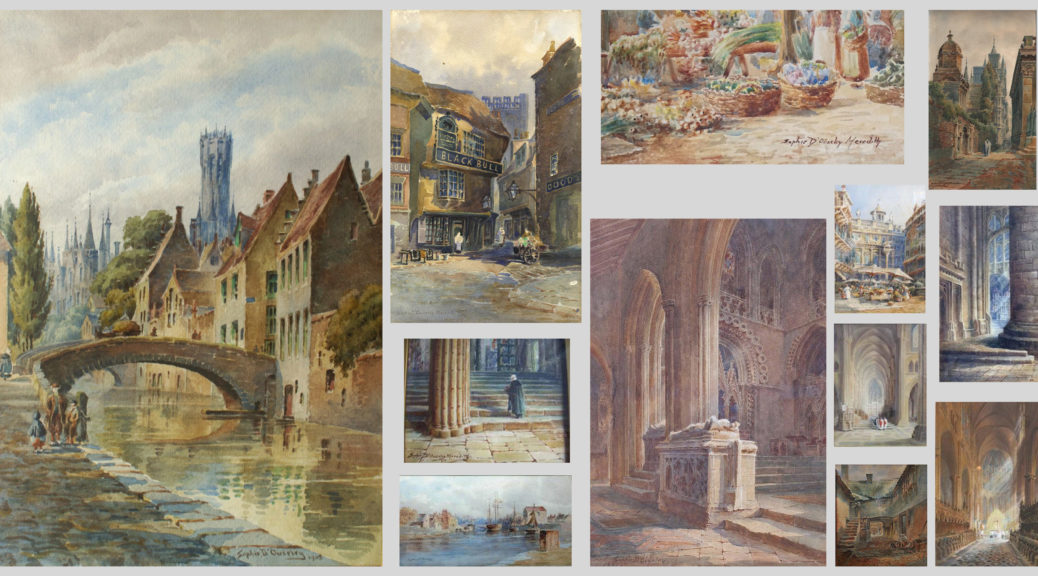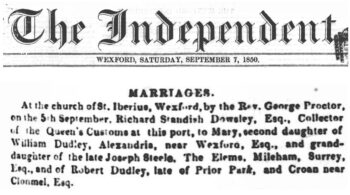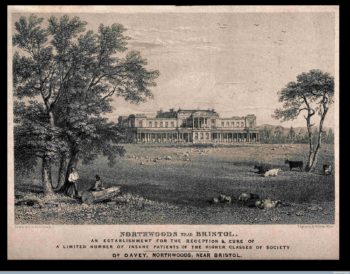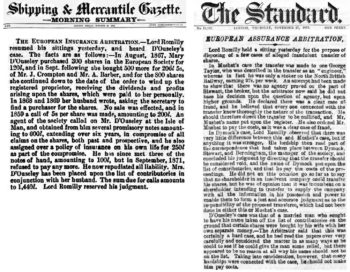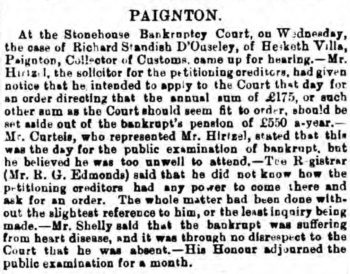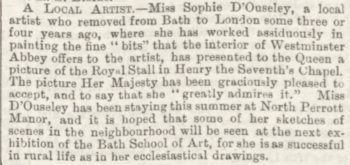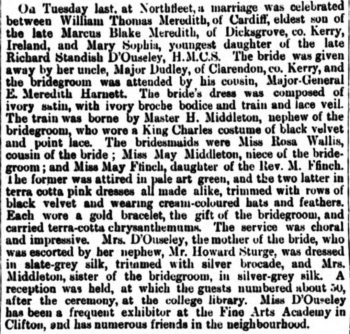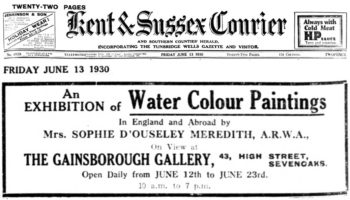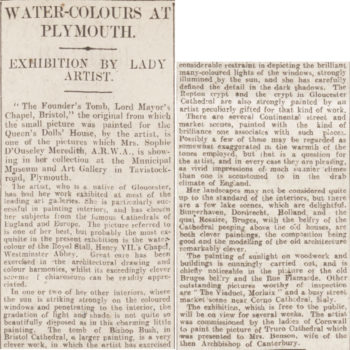My stepmother Margo’s grandmother, Mary Sophie D’Ouseley, made a name for herself as a watercolor painter (a small selection of works is above) in the late 1800s. I remember Margo’s mother, Rose, had a few of her mother’s paintings when we were kids – she lived with us for a few years in the 1960s when we were “between parents”. I had no idea about D’Ouseley family history – if Rose knew, she didn’t say, and of course we never asked at the time. Mary Sophie’s father, Richard Standish D’Ouseley, had died in 1886, long before Rose was born, and Mary D’Ouseley died when Rose was 2, so she never knew her mother’s parents. Mr. & Mrs. D’Ouseley didn’t live together for a substantial part of their marriage so there’d have been no big family Christmas gatherings anyway. Fortunately, newspaper archives and online records help to sketch out parts of the D’Ouseley family’s story.
Mary Sophie D’Ouseley was born September 1st 1854 in Tramore, Waterford, Ireland, third of four children of Richard Standish D’Ouseley and his second wife, Mary Dudley. Richard was 50 when Mary Sophie was born. Her father worked for HM Customs in a variety of positions, first in Westport, Ireland then Wexford, Waterford, Dundalk, Douglas (Isle of Man) and he retired from West Hartlepool, Durham in about 1876. He was Collector of Customs at the last three locations, an important post given Customs revenue was nearly half of the UK’s total government revenue (1853). His work rhythm was akin to a military life where you get posted somewhere else every few years.
Richard married for the first time around 1838 in Ireland. He was baptized into the Catholic church in New Ross, Wexford, Ireland age 34, presumably in connection with his marriage to Eliza Shearman (conjecture). The parish register gives his birth date as well as baptism and ads the text: ad fidem catholicam conversus; roughly, I converted to the Catholic faith.
In the directories of government officials, as well as on his belated baptism, Richard initially is Richard Dowsley, then changes to Richard D’Ousley and finally Richard D’Ouseley – the spelling varies a bit, but appears to have been Dowsley in Ireland and then gradually shifted over time. Possibly he was trying to downplay his Irish origins? His children used D’Ouseley most of the time – with or without the second e, with or without the apostrophe.
He had three children with Eliza, two of whom “ran away” to sea – at 17 and 15, signed up as indentured apprentices in the Merchant Navy. Sadly, the older boy George drowned at sea (William made it home and retired as a Trinity pensioner). The youngest, Rosamund, lived with Richard and his new family for a while longer, moving to Queensland, Australia and marrying there in 1873.
Unfortunately, Irish census records before 1901 have been lost, so it’s hard to track how long Mary Dudley lived with her husband and children in Ireland, but at least through September 1857 when their last child, Charles, was born. She isn’t in the household on the Isle of Man for either the 1861 or 1871 census, and in a legal case (details to come) in 1873, it states that Mr. D’Ouseley is “…now living apart from his wife”.
Mary Sophie lived with her siblings and a servant in Douglas with at least one move (between 1861 and 1871 censuses) in their stay there. I can’t find their mother in any census before 1881, but if she was living in Ireland, she’d be effectively invisible. In the 1881 census, Mary Sophie and her mother are living together in Bath, and in the summer of 1879, a report in The Cornishman on a fundraiser for a School of Art in Penzance has both of them contributing works to sell at the bazaar. Mum is now “Marie D’Ouseley”!
In 1869 -70, Mary D’Ouseley was, apparently, in Northwoods Asylum (near Bristol). This may have been connected to the share purchases she made, using her own money, in the European Insurance Company in 1867. Unfortunately this register of patient admissions and discharges doesn’t list a reason for admission, but it does say she was a private patient.
The Dudley family had money, and possibly Mary had inherited something when her father, William Dudley, died in 1863 and that was in her control? The name and spelling are sufficiently unusual (I couldn’t find any other Mary D’Ouseley in the 1871 census who could have been this patient), I think this is probably her; possibly out of control spending might have been part of what triggered her stay at Northwoods. I am assuming Richard D’Ouseley paid for her admission – the caption on the engraving is priceless. One needs to rub elbows with the best people when in an asylum…!
Two articles (of many) about the D’Ouseley case outline what happened – that Mrs. D’Ouseley made two purchases totaling 800 shares for £326 (about £45,000 in today’s terms) in 1867.
Richard tried to have the agents sell the shares in 1868 and 1869, but that didn’t happen, and they came looking for him in the Isle of Man in 1869 when there was a call on the shares totaling £200 (£30,000 in 2024 terms). They made him a deal for this plus any future calls for three times that amount, and he made payments until 1871 when he had had enough and refused to continue paying.
The company sued Richard in1873 for the amount owing, which is reason we know about these purchases at all. He claimed they weren’t his shares, but his wife’s, purchased with her money and they were living separately. The agents argued that he’d paid on some of the promissory notes already, establishing it was his debt as much as his wife’s.
By 1873, they were seeking £1,440 (almost £200,000 in 2024 terms)!
Richard lost the case, although the judge did not award him costs, sparing him that additional burden. Richard was still working for the Customs Office – he moved to West Hartlepool, Durham, in 1872 and retired in 1876. He moved to Devon with one of his daughters (the papers just say Miss D’Ouseley, but I think it was Elizabeth) and declared bankruptcy in 1877, I assume as a result of these debts to the European Insurance Company. The bankruptcy court in Paignton proposed taking £175 a year from his £550 (over £80,000) per year pension (from HM Customs) but he didn’t show up for the hearing as he was unwell with heart problems. It’s unclear if they discharged his bankruptcy, but he was living in Clapham with his daughter Elizabeth in 1881 and a servant (so they weren’t entirely broke). Richard died in 1886.
Mary Sophie D’Ouseley, sometimes with her mother, appeared in many newspaper stories starting in 1879 about local art shows and exhibits or prizes from art school events. At first her work was in the amateur section of shows, with comments rather perfunctory as if the reviewer was bored, such as this example: “Miss Sophie d’Ouseley also contributes interiors of an ecclesiastical character, well done and pleasing in tone” . After the Queen “accepted” one of her paintings of the interior of Westminster Abbey in 1887, that went the equivalent of viral in late 1800s terms – many papers around the country made mention of it. Sophie was then commissioned to paint the interior of Truro Cathedral and her work appeared in the professional section of future shows.
The snotty Illustrated London News put a story about a London exhibit Sophie’s work was in (1890) in a section “Minor Art Exhibitions” The group was “The Society of Lady Artists” . In that era, I think reviewers saw women’s art as decoration and it wasn’t taken very seriously. The show review begins: “This society, which has now reached its thirty-fifth year of existence shows, notwithstanding its advanced age, no symptoms of infirmity or decay.” Borders on the rude, reading it from a 21st century perspective.
Mary Sophie married William Thomas Meredith in 1890 and her mother was there, escorted by her nephew. It mentioned that Miss D’Ouseley “…has been a frequent exhibitor at the Fine Arts Academy in Clifton, and has numerous friends in the neighbourhood.” She continued to paint and exhibit even though she moved to Wales (1891 census) had her first child in 1894 and her second in 1899 – and somewhere in between moved to Nailsworth, Gloucestershire.
Exhibitions included Cheltenham’s Fine Arts Society. A report from 1907 on a show was funny – in complaining that the oil paintings were not of a high quality and the better watercolors were in a gallery with bad light. His advice? “…it might he wise, another year, to place some of the oils – the worst of them, perhaps – in this smaller apartment, and group the water colours at one end of the principal gallery. That would be fairer to the water-colourists, while the visitor possessed of knowledge of Art would receive a better impression of the merits of the exhibition if the cruder oil paintings were placed in the position…round the corner“
And where were the children during all this painting and exhibiting? Boarding school – not even together, at least as of the 1911 census. These were small schools with a handful of pupils, and while the education may have been fine, it seems to me a shame that the two girls grew up apart from each other and their parents (this wasn’t unusual at the time; both my parents went away to boarding school at young ages too).
There was a gap for the war years and then some solo shows like this one through the 20s and 30s. An advertisement in The Cornishman in 1918 for an auction of a man’s collection of local paintings includes Sophie D’Ouseley by name, presumably as she was well-enough known for that to help the sales. And still she was a “Lady Artist”!
Sophie’s husband died in 1926 and she went to live with her daughter Rose and son-in-law Derek in Cheltenham. She died in 1933.
A decade after her death, an estate auction in Wakefield, Yorkshire mentions two artists by name in describing the watercolor works for sale – one of whom is “Miss D’Ouseley”.

